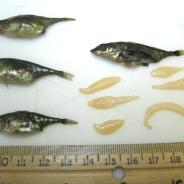Schistocephalus solidus is a tapeworm that requires three hosts in its life cycle: fish, birds and copepods. Sticklebacks become infected after eating an infected copepod. Within the fish, the worms can grow very large and consume a lot of oxygen from the host, causing it to swim up to oxygen-rich surface waters. When the fish swims up to the surface, it is more likely to be eaten by a bird, which is the parasite's next host. This is a good example of how a parasite can alter the host's behavior for its own purposes: The change in host behavior improves the chances of the parasite life cycle being completed.
also known as
stickleback tapeworm
Schistocephalus
Distribution
Northern temperate regions - same as its fish host
Hosts
threespine stickleback
Detection Methods:
gross pathology / gross clinical signs
Target tissue
Resides in body cavity
References

